Visita al Duomo di Milano: l'opera gotica più grande al mondo
Duomo di Milano: i biglietti più scelti dai viaggiatori
Il Duomo di Milano: una meraviglia architettonica
Il Duomo di Milano è costruito prevalentemente in marmo bianco e rosa proveniente dalle cave di Candoglia, nel Verbano-Cusio-Ossola, e si caratterizza per un’imponente facciata gotica che si staglia verso il cielo con le sue alte guglie e statue intricate. Iniziato nel 1386 e completato solo secoli dopo, racchiude in sé diversi stili e tecniche architettoniche. Al suo interno puoi trovare tratti del Gotico Internazionale, dello stile neoclassico e del neogotico.
Ogni elemento della cattedrale è un'opera a sé stante, dalle delicate decorazioni scultoree ai bassorilievi che raccontano storie religiose e allegoriche. Considerata l'opera gotica più grande al mondo, la Cattedrale, è lunga 157 metri e sulla guglia maggiore, alta 108,5 metri, svetta la statua dorata della Madonnina, simbolo amato da tutti i milanesi e non solo.
L’interno è suddiviso in cinque navate principali e due navate laterali più piccole. Le navate sono separate da imponenti colonne in marmo di Candoglia, alte oltre 24 metri, scolpite con motivi floreali e figure bibliche. Queste creano un effetto visivo straordinario, accentuato dalla luce che penetra attraverso le vetrate.
Proprio queste vetrate sono una caratteristica architettonica importante del Duomo. Esso, infatti, vanta una collezione di vetrate istoriate più grandi al mondo. Le vetrate, che risalgono a diversi secoli, narrano episodi dell’Antico e del Nuovo Testamento, con un’esplosione di colori e dettagli che catturano la luce naturale in modi incantevoli.
Esternamente, il Duomo è ornato da oltre 3.400 statue. Tra queste, spiccano gargoyle intricati e statue che rappresentano santi, angeli e figure storiche. La facciata principale, completata solo nel XIX secolo, è un esempio di integrazione tra il gotico originale e il neogotico.
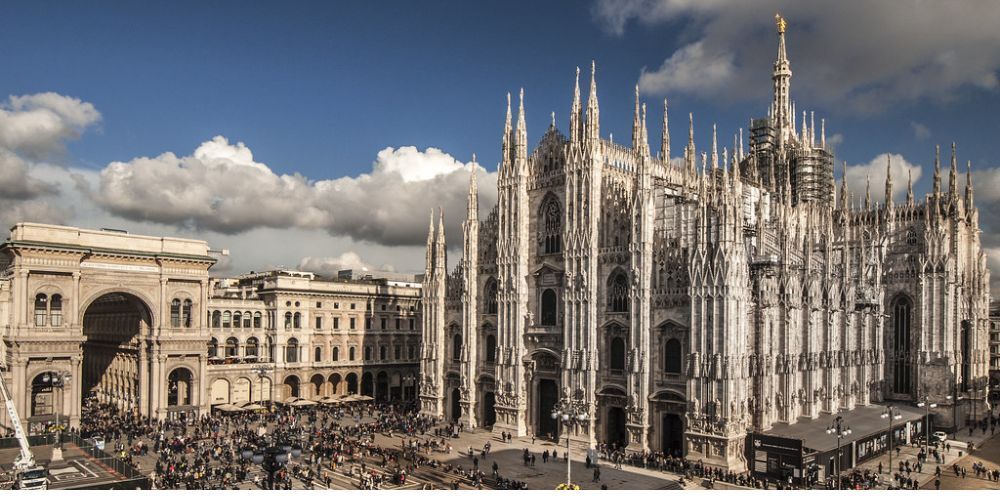
Scopri tutte le altre esperienze
Informazioni e orari di apertura del Duomo di Milano
Vediamo adesso un po di informazioni sul Duomo: ovvero, quali sono gli orari di apertura, quali sono i prezzi dei biglietti e l'accessibilità.
Per quanto riguarda gli orari di apertura, il Duomo è aperto tutti i giorni dalle 8:00 alle 19:00. Le terrazze aprono invece dalle 9:00 alle 19:00 (ultimo ingresso alle 18:10). Di notte, il Duomo non è accessibile, ma la facciata illuminata è visibile e dona un'atmosfera suggestiva alla piazza.
Accessibilità
Consigli per la Visita
Gli orari meno affollati sono la mattina presto o il tardo pomeriggio nei giorni feriali.
Duomo di Milano: consigli per la tua visita
Come raggiungere il Duomo di Milano
Se il tuo viaggio prevede una sosta di qualche giorno nella città di Milano, ti sarà più facile arrivare al Duomo. Ma anche nel caso tu sia di passaggio per un giorno e tu abbai pianificato di visitare il Duomo, ci sono molte soluzioni per raggiungerlo.
Le migliori esperienza a Milano
Duomo di Milano: le migliori attrazioni nei dintorni
i migliori luoghi da visitare
Palazzo Te Mantova
MilanoVilla Necchi Campiglio
MilanoTrenino Rosso del Bernina
MilanoStadio di San Siro
MilanoTeatro alla Scala
MilanoTour del Lago di Como
Lago di ComoIl Duomo di Milano: biglietti, curiosità e come salire sulle Terrazze della Cattedrale
Hai mai fatto una visita completa del Duomo di Milano? Sali sulle terrazze, visita il Museo, riserva il biglietto, vivi con noi questa esperienza!
Read more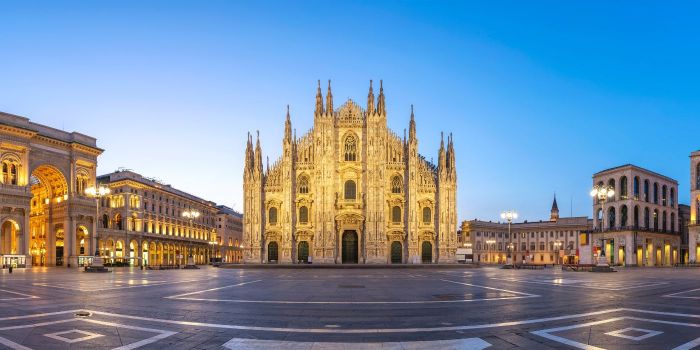
Domande frequenti sul Duomo di Milano
Come si fa per visitare il Duomo di Milano?
Per raggiungere gli ingressi principali del Duomo di Milano, prendi la linea gialla della metropolitana (M3) dalla Stazione Centrale, scendi alla fermata Duomo e da lì cammina verso Piazza del Duomo. Orari d'ingresso: gli ingressi principali sono aperti tutti i giorni dalle 09:00 alle 19:00.
Quanto ci vuole a salire a piedi sul Duomo di Milano?
Per salire in cima al Duomo servono circa 10 minuti, ma ovviamente la durata può variare anche in base alla quantità di persone presenti e al tempo trascorso ad ammirare le guglie e l'architettura.
Quanto costa il biglietto per entrare nel Duomo di Milano?
Per entrare al Duomo ci sono varie opzioni di biglietto. Il Duomo Pass che comprende: Cattedrale, Terrazze, Area Archeologica, Museo: 20 € con ascensore, 15 € con scale.
Il biglietto solo Terrazze: 15 € con ascensore, 10 € con scale.
Museo + Area Archeologica invece: 10 € (ridotto 5 €).
Quando è gratis il Duomo di Milano?
È possibile accedere gratuitamente alla Cattedrale durante le messe religiose, ma non per visite turistiche.
Quanto costa salire sulla Madonnina?
Salire sul Duomo di Milano alle terrazze, costa 15 € con l'ascensore e 10 € con le scale. Da qui, puoi ammirare da vicino la Madonnina e un panorama mozzafiato su tutta la città.
Dove comprare i biglietti del Duomo di Milano?
I biglietti del Duomo di Milano si possono acquistare online sul sito ufficiale del Duomo, presso la biglietteria in Piazza Duomo 14/A o tramite piattaforme come Musement o Tiqets.
Quanto costa salire sulle guglie del Duomo di Milano?
Tetto a piedi: costa 10 € e permette di salire alla Terrazza del Duomo solo a piedi. Tetto in ascensore: costa 14 € e permette di salire alla Terrazza del Duomo solo con l'ascensore. Tetto serale: costa 14 € e consente di salire alla Terrazza del Duomo con l'ascensore solo dopo le 19:00.
Quanto ci vuole dalla Stazione Centrale di Milano al Duomo?
La distanza è di 3 km. Come detto, la soluzione migliore è quella di utilizzare la metro, in questo caso, la m3 che in 13 minuti ti poterà in piazza Duomo.
Cosa non portare al Duomo di Milano?
La Cattedrale è un luogo aperto al pubblico, ma ha le sue regole. Al suo interno, non è possibile portare caschi, oggetti di vetro e valigie e quanti altri oggetti ritenuti pericolosi dalla Veneranda Fabbrica del Duomo. Ti suggeriamo anche di non portare all'interno della Cattedrale borse voluminose.
Quanto costa il biglietto per la metro a Milano?
Spostarsi a Milano in metro è molto semplice, in vari punti della città si trovano le stazioni delle linee viola, gialla, rossa, blu. Il costo del biglietto è per una corsa normale di 2,20 euro. Se si decide di fare il biglietto giornaliero il prezzo è di 7,60 euro.
Chi è il proprietario del Duomo di Milano?
Il Duomo è di proprietà della Veneranda Fabbrica del Duomo di Milano, l'ente storico fondato nel 1387 per supervisionare la costruzione e la manutenzione della cattedrale.
I migliori Tour per visitare il Duomo di Milano
Nel 2023 il Duomo di Milano ha registrato oltre 3 milioni di visitatori e i numeri sono in tendenza anche per il 2024. Per questo motivo, essendo una delle strutture più visitate d'Italia è bene organizzarsi, prenotando dei tour. le migliori visite guidate per visitare il Duomo sono quelle che ti consentiranno di scoprire i segreti e la storia.
Il Tour classico prevede una guida ufficiale e la visita ai principali punti di interesse, come il Duomo stesso, la statua di San Bartolomeo, l’area archeologica e la famosa terrazza panoramica. I biglietti includono il “salta-fila” e hanno una durata media di 1-2 ore. I costi partono da circa €35 a persona.
In alternativa ci sono i Tour Privati: Disponibili per piccoli gruppi (fino a 10 persone) o gruppi più ampi, questi tour privati permettono di personalizzare il percorso e possono includere anche il Duomo Museum e altre aree riservate. I costi variano, partendo da circa €200 per gruppo ridotto e includono l’ingresso prioritario.
Il Duomo Pass è per chi vuole esplorare tutto il complesso, questo pass include l’accesso alla cattedrale, alle terrazze (sia in ascensore sia a piedi), all’area archeologica e al Museo del Duomo. I prezzi per il pass completo variano dai €20 ai €30, con validità di 72 ore, ideale per chi preferisce un'esplorazione autonoma.
Tour Educativi per Scuole e Università: Questi programmi personalizzati, offerti dall’Ufficio Educazione della Veneranda Fabbrica, sono pensati per scuole e università, con approfondimenti storici e tecnici. Le attività sono orientate a studenti di tutte le età e possono essere prenotate contattando direttamente l'ufficio educativi.
Tour con Realtà Aumentata e Virtuale: attraverso esperienze digitali, i visitatori possono scoprire dettagli architettonici e artistici della cattedrale in modo interattivo. Queste attività multimediali sono ideali per chi cerca un'esperienza immersiva oltre il tradizionale tour.
Tour delle terrazze con guida: Consente di esplorare i dettagli della struttura gotica delle guglie e delle statue, con viste spettacolari.
Per chi preferisce ritagliarsi del tempo a fine giornata, invece, c'è il tour serale del Duomo e della Piazza del Duomo: esso offre la possibilità di visitare i dintorni del Duomo e apprezzarne la bellezza sotto la suggestiva illuminazione notturna.
Le curiosità sul Duomo di Milano
Come ogni monumento che si rispetti, anche sul Duomo di Milano, ci sono alcune curiosità da sapere.
Come prima cosa: la durata dei lavori. Si è trattato di un cantiere lungo 600 anni! La costruzione del Duomo è durata più di sei secoli, e ancora oggi sono in corso lavori di restauro e manutenzione.
La seconda che ti segnaliamo riguarda la "Madonnina", simbolo lucente che domina la città, e l'altezza del Duomo. Per tradizione, nessun edificio a Milano deve superare in altezza la statua della Madonnina. Questo rispetto si è mantenuto, tanto che anche la moderna torre UniCredit, la più alta di Milano, ospita una copia della Madonnina sulla cima. E poi, tanta lucentezza, fu un problema durante la Seconda Guerra Mondiale. Infatti, i milanesi decisero di coprirla con degli stracci per non dare punti di riferimento ai bombardieri.
Poi ci sono dei misteriosi simboli scolpiti. Il Duomo, infatti, è adornato da migliaia di sculture e simboli curiosi, tra cui una statua di un pugile con i guantoni. La ricchezza di dettagli suscita grande fascino e stupore. Divertiti a scoprirne quante più riesci e condividile con amici e parenti.
Cripta e Tesoro del Duomo
La cripta ospita le spoglie di San Carlo Borromeo, conservate in un’urna di cristallo e argento. Questo spazio sotterraneo è un luogo di raccoglimento e preghiera, arricchito da dettagli architettonici semplici e suggestivi. Il Tesoro del Duomo, accessibile tramite visite guidate, custodisce preziosi oggetti liturgici, tra cui calici, reliquiari e paramenti sacri, oltre a un crocifisso attribuito a Pellegrino Tibaldi.
Sempre sotto il Duomo di Milano si trovano i resti del Battistero di San Giovanni alle Fonti, risalente al IV secolo e considerato uno dei più antichi battisteri cristiani occidentali. L’area archeologica rivela anche frammenti della basilica paleocristiana su cui sorge il Duomo, testimoniando l’importanza religiosa del sito fin dall’epoca romana.
Personaggi Storici Legati al Duomo
Come spesso accade in Italia, ci sono alcuni personaggi storici che sono legati alle strutture principali delle città. Il Duomo di Milano non è esente da questa regola.
Il primo nome che dobbiamo ricordare è quello di Gian Galeazzo Visconti. Lui fu il promotore principale del progetto, inaugurando i lavori nel 1386. La sua visione trasformò il Duomo in un simbolo dell’identità milanese. Egli scelse lo stile gotico, ispirandosi alle grandi cattedrali francesi e tedesche, e coinvolse maestranze internazionali per lavorare al progetto. Importò marmo di Candoglia dal Lago Maggiore, utilizzando un sistema di trasporto via acqua per agevolare i lavori.
L’arcivescovo di Milano che fu un punto di riferimento per il clero e per i lavori di completamento della cattedrale fu San Carlo Borromeo. In particolare, fece collocare al centro della cattedrale la reliquia del Santo Chiodo, ritenuta parte della croce di Cristo, che oggi è esposta ogni anno durante la Festa della Nivola.
Incoraggiò anche la decorazione e l’abbellimento degli interni del Duomo per riflettere la magnificenza della fede cristiana.
Colui che è considerato l'architetto del Duomo, invece, prende il nome di Pellegrino Tibaldi. Egli, in particolare, fu coinvolto nella costruzione del presbiterio e in altri elementi strutturali, contribuendo alla continuità stilistica del progetto. Tibaldi, che fu incaricato proprio da San Carlo Borromeo, progettò il presbiterio in modo da enfatizzare la centralità dell’altare maggiore, cuore liturgico della cattedrale. Il suo approccio combinò l’eleganza manierista con il rispetto delle proporzioni gotiche già presenti nella struttura. Creò un ambiente solenne e ordinato, che rifletteva gli ideali del Concilio di Trento, volto a semplificare e purificare gli spazi liturgici per favorire la preghiera e la contemplazione.
Veneranda Fabbrica del Duomo
Fondata nel 1387, la Veneranda Fabbrica del Duomo è l’ente che ha gestito e continua a occuparsi della costruzione e manutenzione della cattedrale. Ancora oggi, si occupa dei restauri e dell’organizzazione degli eventi legati al Duomo.
Eventi e celebrazioni
Il Duomo è il cuore della vita religiosa milanese, ospitando celebrazioni solenni come la messa di Natale e quella di Pasqua. È anche sede di concerti di musica sacra grazie all’acustica eccezionale dell’edificio. La festa più importante è quella della Nivola, in settembre, durante la quale viene esposta la reliquia del Santo Chiodo. Ogni 4 novembre, il Duomo ospita liturgie solenni dedicate al patrono della diocesi di Milano.















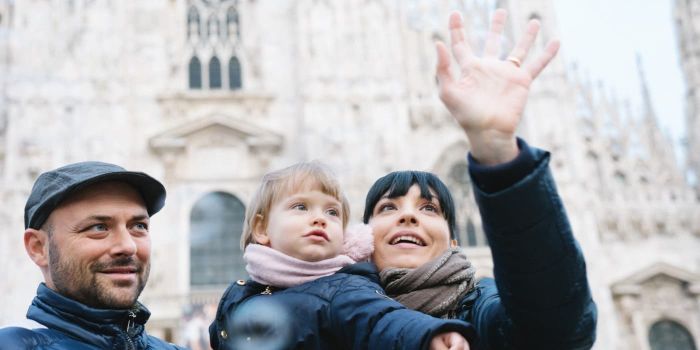
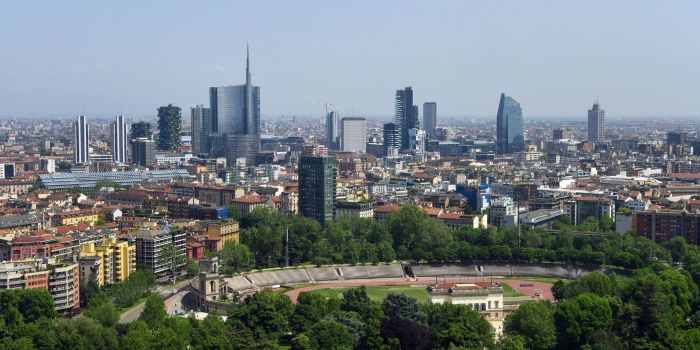
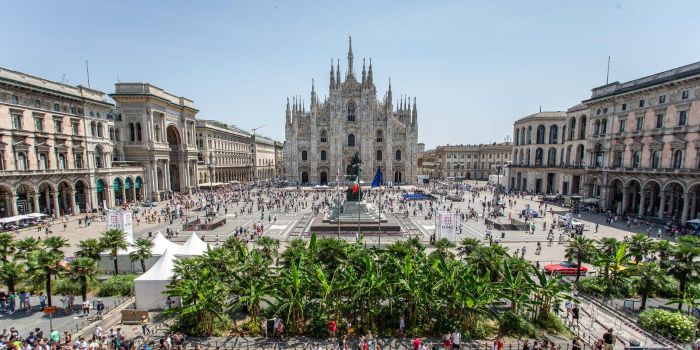
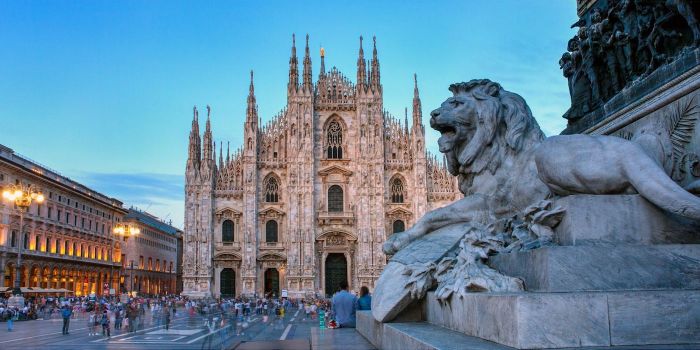
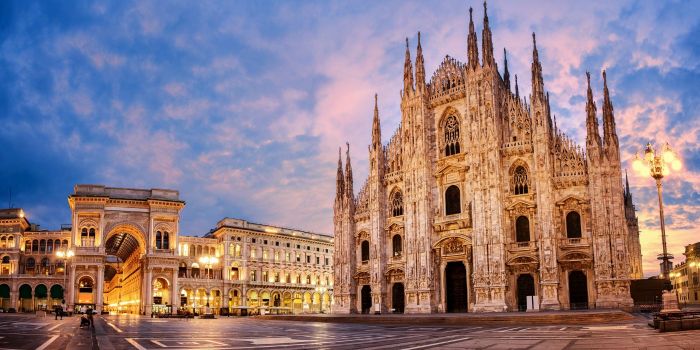
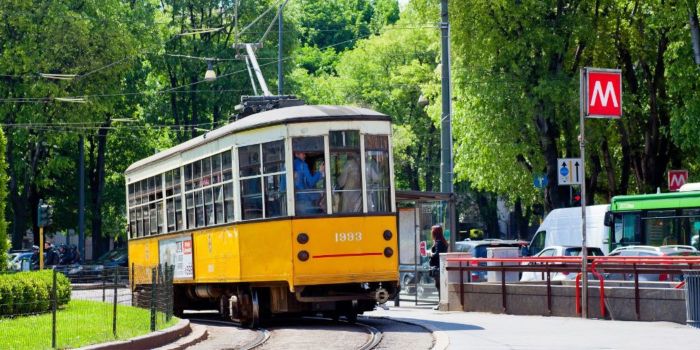





Lorenzo Braccini
Il Duomo di Milano rappresenta l'icona della città lombarda, la Madonnina che si trova in alto, in cima ad esso, è visibile da molti punti della città. Scopri come visitare il Duomo di Milano con i tour che ti consigliamo.